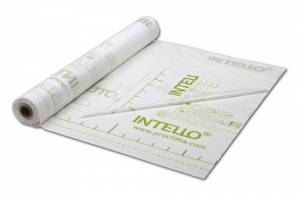Intello Plus vapour
Available in all stores
Conditionnement
Rouleau de 1,5 m ou 3 m x 50 m
Unité de vente
Au mètre courant ou au rouleau
INTELLO PLUS Vapour
High-performance reinforced intelligent vapour check, suitable for all fibrous insulationAdvantages
- Maximum protection for the insulation
- Ideal prevention against structural damage and mould, even in the event of unexpected moisture intrusion
- Extremely high moisture-variable diffusion resistance in any climate spanning a very wide range of more than 100 x:
sd-value: 0.25 m up to >25 m
g-value: 1.25 MNs/g up to > 125 MNs/g
water vapor permeance: 13.12 US perms down to <0.13 US perms - High protection from condensation in winter climate
- High back-diffusion capacity in summer
- Very low coefficient of expansion when combined with spray insulation materials
- Lowest VOC rating in hazardous substance test
Application
Can be used as a vapour check and airtightness membranes for all externally diffusion-open structures, e.g. with roof underlay (pro clima SOLITEX), softwood fibreboard or MDF board. For a high level of protection against moisture induced failures in structurally challanging constructions such as diffusion-resistant flat/pitched roofs. Also suitable in extreme environments such as in high mountain regions. Further information is given in the study “Calculating potential freedom from structural damage of thermal insulation structures in timber-built and steel systems”
Technical specs
| Material | |
| Fleece | Polypropylene |
| Membrane | Polyethylene copolymer |
| Reinforcement | Polypropylene non-woven fabric |
| Attribute | Norm | Value |
| Colour | white-transparent | |
| Surface weight | EN 1849-2 | 110 ±15 g/m² |
| Thickness | EN 1849-2 | 0.40 ±0.1 mm |
| Water vapour resistance factor µ | EN 1931 | 18 750 |
| sd-value | EN 1931 | 7.50 ±0.25 m |
| sd-value humidity variable | EN ISO 12572 | 0.25 - >25 m |
| g-value | 37.50 ±1.25 MN·s/g | |
| g-value humidity variable | 1.25 - >125 MN·s/g | |
| Water vapor permeance | ASTM E 96 | 0.44 US perms |
| Water vapor permeance humidity variable | ASTM E 96 | 13.12 - <0.13 US perms |
| Fire behaviour | EN 13501-1 | E |
| Tensile strength MD/CD | EN 13859-1 | 350 N/5 cm / 290 N/5 cm |
| Elongation MD/CD | EN 13859-1 | 15 % / 15 % |
| Nail tear resistance MD/CD | EN 13859-1 | 200 N / 200 N |
| Artificial ageing by long term | EN 1296 / EN 1931 | passed |
| Temperature resistance | -40 °C/-40 °F to +80 °C/176 °F | |
| Coefficient of thermal conductivity | 0.17 W/m·K | |
| Airtightness | EN 12114 | tested |
| National technical approval (DE) | DIN 68800-2 | Z-9.1-853 |
| CE labelling | EN 13984 | available |
Limiting factors
Pro clima INTELLO PLUS should be laid with the side with the plastic film (the printed side) facing the installer. They can be laid flat either at right angles to or along the sub-structure (such as the rafters) without sagging. If laid horizontally (at right angles to the sub-structure) then the maximum space permitted between the rafters is 100 cm. After laying, it is necessary to support the weight of the insulation with lathing on the inside. The laths should be no more than 50 cm apart. If, when using insulation mats and boards, for example, you expect systematic tension as a result of the insulation weight on the adhesive tape joins, an additional supporting lath should be placed on the overlap. Alternatively, the adhesive tape can be reinforced along the overlap by sticking strips of adhesive tape at right angles to the overlap every 30 cm.
Airtight seals can only be achieved on vapour control membranes that have been laid without folds or creases. Ventilate regularly to prevent excessive humidity (e.g. during the construction phase). Occasional rush/inrush ventilation is not adequate to quickly evacuate large amounts of construction-related humidity from the building. Use a dryer if necessary.
To prevent condensation, INTELLO PLUS should be stuck down so that it is airtight immediately after installing the thermal insulation. This particularly applies when working in winter.
Additionally for injected foam insulation
INTELLO PLUS can also be used as a membrane for all types of injected foam insulation. Your reinforcing layer prevents stretching during injection of the insulation foam. If laid along the sub-structure it has the advantage that the overlap is supported on a firm foundation and is therefore protected.
To prevent condensation, the injected foam insulation should be introduced immediately after installing the airproofing layer. This particularly applies when working in winter.
